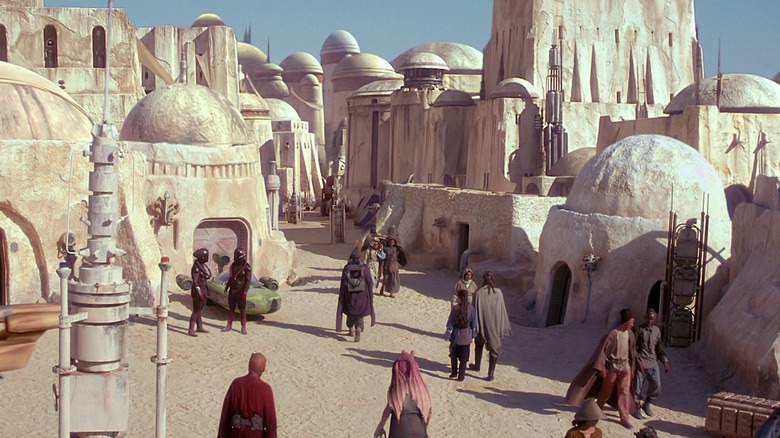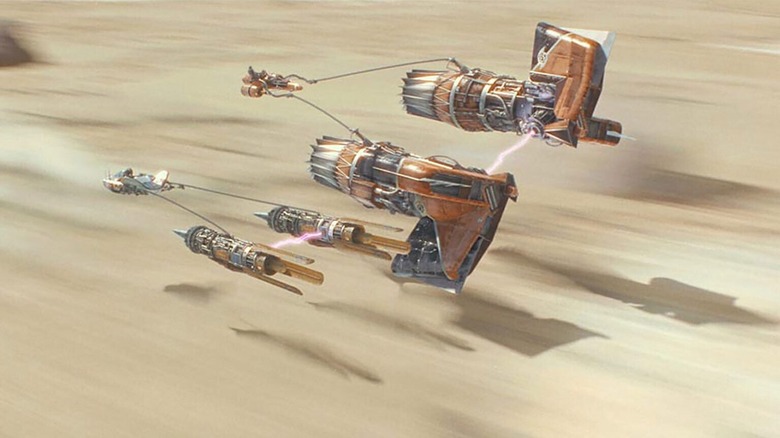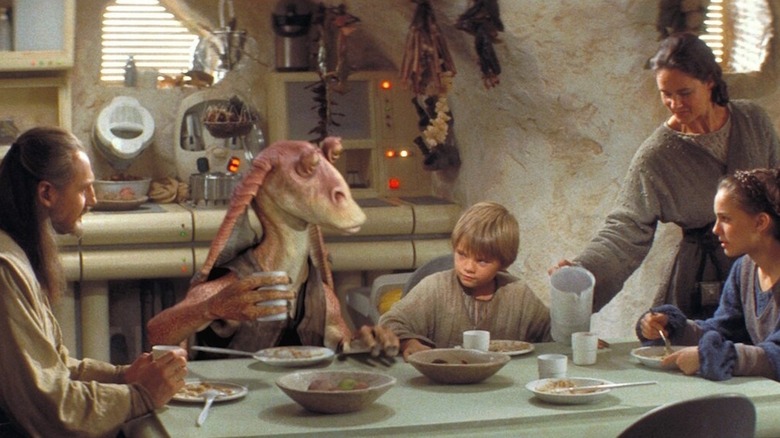A Familiar Star Wars Disaster Destroyed The Tatooine Set Of The Phantom Menace
George Lucas hadn't officially directed a movie in 20 years when he stepped back behind the camera for "Star Wars: Episode I – The Phantom Menace" in 1997, and it didn't take long for him to remember why, starting with 1980's "Star Wars: Episode V – The Empire Strikes Back," he'd left the business of shouting "Action!" and "Cut!" to hired hands.
Anticipation for a new, canonical, live-action "Star Wars" movie was feverish. Lucas had been teasing the possibility of a prequel trilogy for over a decade, and now he was set to tell the tragic saga of how a young Anakin Skywalker betrayed his wife, his mentor, and his fellow Jedi to become Darth Vader. The pressure was immense, but Lucas produced these movies independently of their distributor, 20th Century Fox. He could blow a release date deadline if he absolutely had to. The franchise changed Hollywood in 1977, and, with promised advancements in CG, seemed poised to do so again. He wasn't playing with house money, but he was at the helm of a movie that would likely shatter multiple box office records. He was on his own schedule.
Still, he wasn't exactly keen on directing. Indeed, when I interviewed the Olivier Award-winning playwright David Hare in 2008, he revealed to me that Lucas had asked him to co-direct "The Phantom Menace" (Hare would handle the actors, while Lucas oversaw the non-human elements). Lucas finally decided to do it all himself (and we can debate whether that was a good idea), but he might've regretted it when a storm in the Tunisian desert threatened to wreak havoc on the film's Mos Espa sets.
A hurricane and a tornado combined
Lucas was well acquainted with the unpredictable temperament of this location. The heat could be close to unbearable, but the storms, which rolled in quickly and were packed with devastating potential, could lay waste to a film set. One night, Lucas spotted an ominous gathering of clouds making tracks for their Mos Espa set.
As he told Laurent Bouzereau and Jody Duncan in "Star Wars: The Making of Episode I – The Phantom Menace:"
"It didn't look good to me. I had been through the same experience on the first 'Star Wars' — it was as if the storm had hidden away for twenty years, just waiting to come back! When we started to hear thunder, I asked [producer] Rick McCallum, 'What are we going to do tomorrow?' And he said, 'Don't worry — we'll shoot. But he was being optimistic.'"
McCallum and production supervisor David Brown hopped in all-terrain vehicles to survey the damage during the storm, which proved unwise. "It was like a hurricane and a tornado combined," said McCallum. "It was terrifying. Wind was hitting my car so hard, I thought we were going to be turned over. So we went back to the hotel and just waited. When the storm let up a bit, I went back out to the sets — or what was left of them."
The trouble with sand
Once the storm passed, the only set left standing was the landing ramp for Queen Amidala's spacecraft. This was far from ideal, but it was a stroke of good luck. Lucas and company were able to rearrange the shooting schedule to shoot the scenes involving Amidala's ship while repairing and replacing everything — from pod racers to costumes and wigs — that had been destroyed in the tempest.
Though scrambling created some unusual hurdles (at one point, Natalie Portman's shoes got stuck in fresh paint), the production wrapped its Tunisia shoot on time. For McCallum, it was something of a proving ground. "Tunisia was pure adrenaline [...] and the shoot there was fantastic, despite the problems we had to face. There was a volatility about it that was unnerving, yet exhilarating."
"The Phantom Menace" wound up being a divisive movie (I think it's the best of the Prequel Trilogy because I never feel like Lucas is responding to fan criticism), but on this I think we can all agree: sand sucks. It's coarse and rough and it gets everywhere. Also, David Hare really should've directed the actors.


